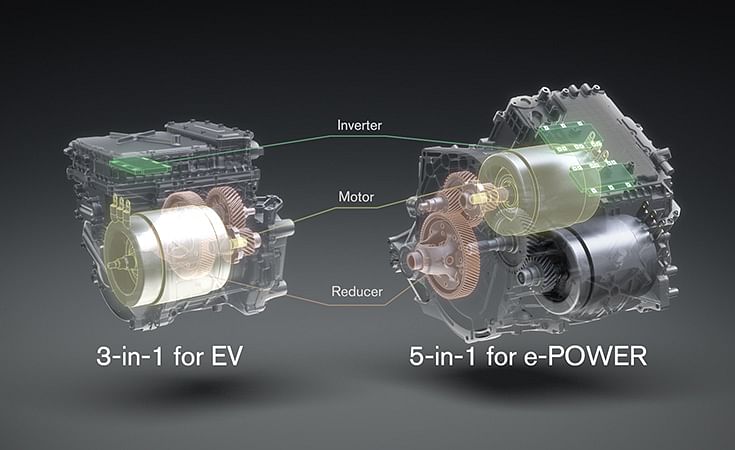Nissan targets 30% cost reduction in electrified powertrains with shared, modularised components
A 3-in-1 powertrain prototype, which modularises the motor, inverter and reducer, is planned for use in EVs. A 5-in-1 prototype, which additionally modularises the generator and increaser, planned for use in e-POWER vehicles.
Nissan today unveiled its new approach to electrified powertrain development, which it calls ‘X-in-1’. Under the approach, core EV and e-Power powertrain components will be shared and modularised, resulting in a 30% reduction, compared to 2019, in development and manufacturing costs by 2026.
Through the X-in-1 approach, Nissan aims to further increase the competitiveness of its EV and e-Power vehicles. Nissan has developed a 3-in-1 powertrain prototype, which modularizes the motor, inverter, and reducer, which is planned for use in EVs. A 5-in-1 prototype, which additionally modularizes the generator and increaser, is planned for use in e-Power vehicles.
The X-in-1 approach, which covers 3-in-1, 5-in-1, and other possible variants, has been developed to enable EV and e-Power core components to be produced on the same line.

In 2010, Nissan became the first automaker to mass-market an EV, the Nissan Leaf. To continuously enhance its electrification technologies, Nissan has been carefully listening to its EV customers around the world. In 2016, Nissan launched its unique e-Power electrified powertrain, utilizing its EV technology, which provides the same driving pleasure as an EV as it is 100% motor drive.
Key benefits of new manufacturing approach
The X-in-1 approach to electrified powertrain development provides the following benefits:
- Sharing and modularising core components improves production efficiencies and reduces powertrain costs by approximately 30% compared to 2019. Nissan aims to achieve e-Power price parity with ICE vehicles by around 2026
- Size and weight reduction of the unit improves vehicle driving performance and minimizes noise and vibration
- Adopt newly developed motor that reduces the use of heavy rare earth elements to 1% or less of magnet weight
- The sharing of core components and control technology provides the enjoyable driving experience unique to Nissan EVs
Senior Vice President Toshihiro Hirai, who leads powertrain and EV engineering development for Nissan, said:“We make the most of our expertise and know-how from our more-than-a-decade long development and production of electrified technologies. Through our innovations in electrified powertrain development, we’ll continue to create new value for customers and deliver 100% motor-driven vehicles -- EVs and e-Power -- as widely as possible.”
Under its long-term vision, Nissan Ambition 2030, the company aims to bolster its line-up with 27 new electrified models, including 19 EVs, by fiscal year 2030. Nissan aims to bring the unique value of its electrified vehicles to the broadest range of customers by introducing the most suitable models to each market at the appropriate time.
RELATED ARTICLES
Autoliv Plans JV for Advanced Safety Electronics With China’s HSAE
The new joint venture, which is to be located strategically near Shanghai and close to several existing Autoliv sites in...
JLR to Restart Production Over a Month After September Hacking
Manufacturing operations at the Tata Group-owned British luxury car and SUV manufacturer were shut down following a cybe...
BYD UK Sales Jump 880% in September to 11,271 units
Sales record sets the UK apart as the largest international market for BYD outside of China for the first time. The Seal...






 By Autocar Professional Bureau
By Autocar Professional Bureau
 09 Mar 2023
09 Mar 2023
 6865 Views
6865 Views




















 Ajit Dalvi
Ajit Dalvi




